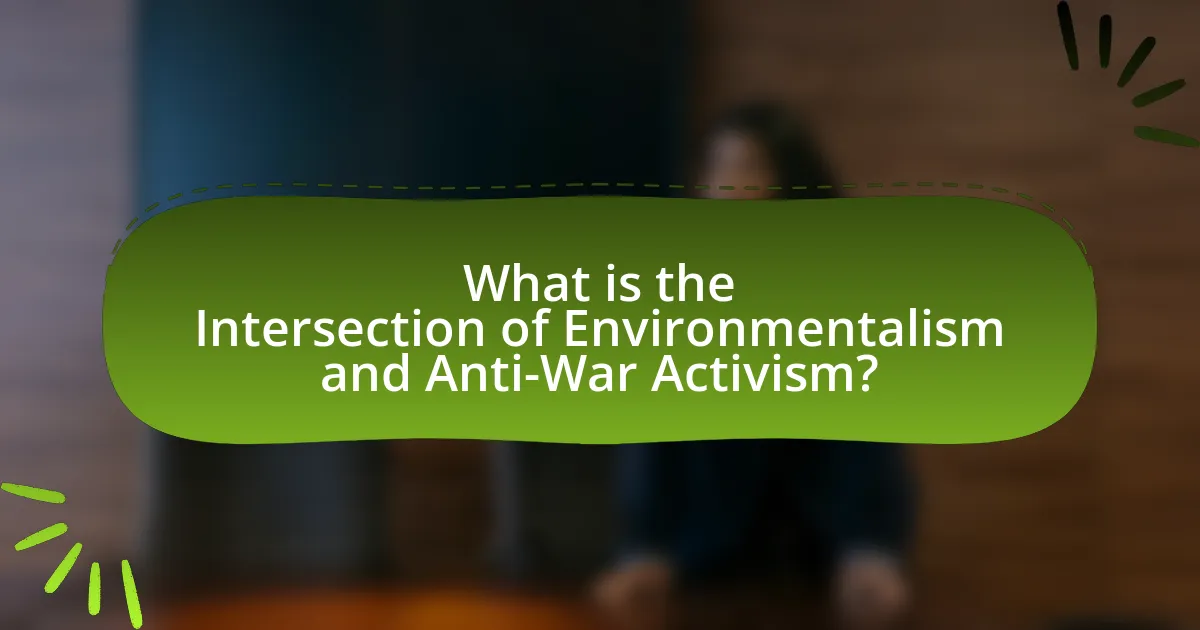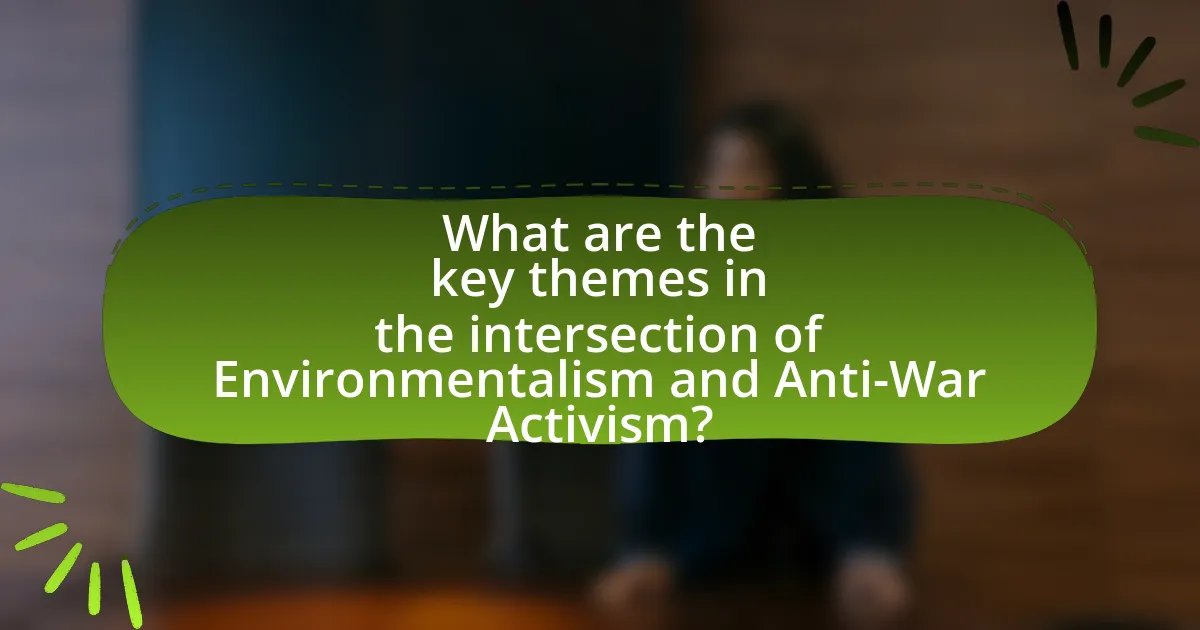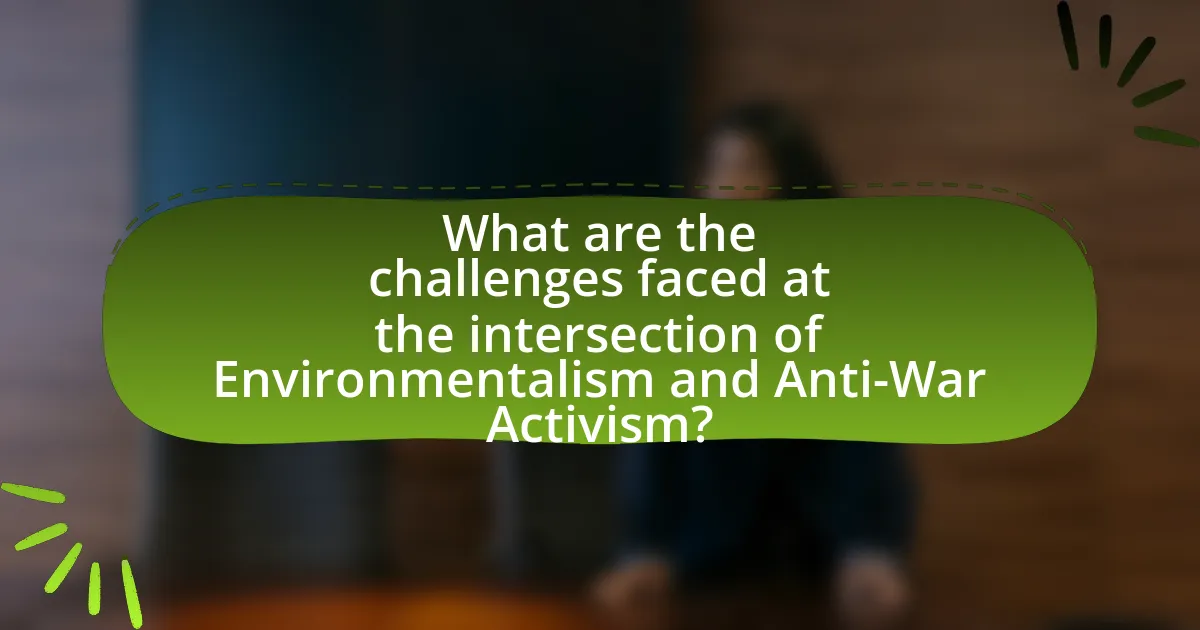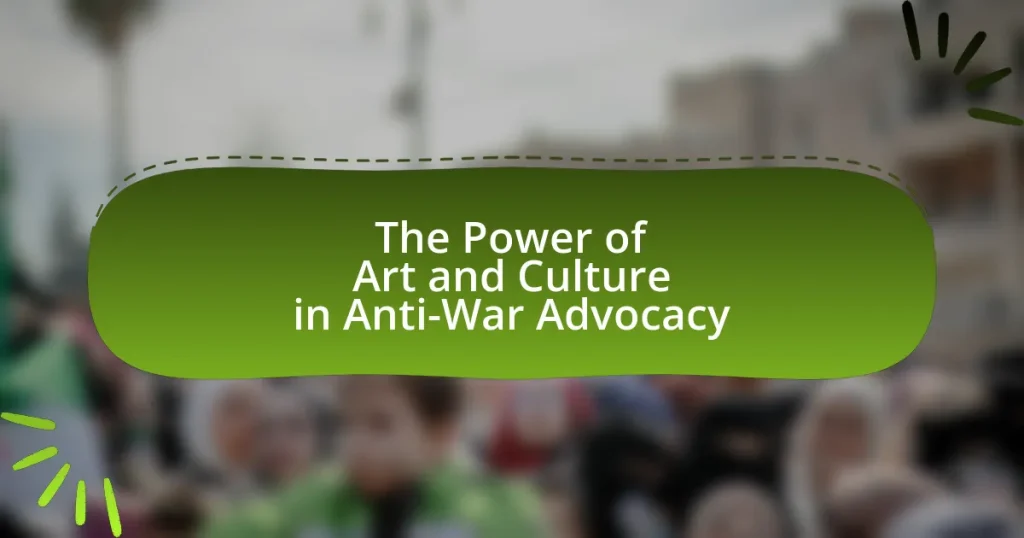The article examines the intersection of environmentalism and anti-war activism, highlighting how militarism and warfare adversely affect the environment. It discusses the shared concerns of both movements regarding pollution, habitat destruction, and climate change, particularly emphasizing the U.S. military’s significant role as a major polluter. Historical events, such as the Vietnam War protests and the anti-nuclear movement, illustrate the longstanding connection between these causes. The article also explores the philosophical overlap, key themes, and challenges faced by activists, while advocating for collaborative efforts to promote peace and environmental sustainability. Additionally, it outlines practical steps individuals can take to support both movements and highlights available resources for activism.

What is the Intersection of Environmentalism and Anti-War Activism?
The intersection of environmentalism and anti-war activism lies in the shared belief that militarism and warfare significantly harm the environment. Environmentalists argue that military activities contribute to pollution, habitat destruction, and climate change, while anti-war activists emphasize the human and ecological costs of conflict. For instance, the U.S. military is one of the largest consumers of fossil fuels globally, leading to substantial greenhouse gas emissions. This connection has led to collaborative movements, such as the Green Party, which advocates for peace and environmental sustainability, highlighting that a peaceful world is essential for a healthy planet.
How do environmentalism and anti-war activism relate to each other?
Environmentalism and anti-war activism are interconnected through their shared focus on the preservation of life and the protection of ecosystems. Both movements emphasize the detrimental impacts of militarism on the environment, as military activities often lead to pollution, habitat destruction, and resource depletion. For instance, the U.S. Department of Defense is one of the largest polluters in the world, contributing significantly to greenhouse gas emissions and toxic waste. This overlap has led to collaborations between environmental groups and peace organizations, advocating for policies that promote sustainability and disarmament.
What historical events have linked environmentalism and anti-war movements?
The Vietnam War protests in the 1960s and 1970s significantly linked environmentalism and anti-war movements. Activists highlighted the environmental destruction caused by the war, such as the use of Agent Orange, which devastated ecosystems and harmed human health. The 1970 Earth Day, emerging from this context, united anti-war sentiments with environmental advocacy, emphasizing the need for peace and ecological preservation. Additionally, the 1980s anti-nuclear movement, which opposed nuclear weapons testing, also intertwined with environmental concerns about radiation and ecological safety, further solidifying the connection between these two movements.
How do the philosophies of environmentalism and anti-war activism overlap?
The philosophies of environmentalism and anti-war activism overlap primarily in their shared emphasis on the interconnectedness of human well-being and the health of the planet. Both movements advocate for the protection of life, whether it be through preventing environmental degradation or opposing the violence and destruction caused by war. Environmentalism highlights the detrimental effects of militarization on ecosystems, as military activities often lead to pollution, habitat destruction, and resource depletion. For instance, the U.S. military is one of the largest consumers of fossil fuels and a significant contributor to greenhouse gas emissions, which directly contradicts environmental goals. Similarly, anti-war activism stresses the moral imperative to protect human life and the environment from the ravages of conflict, arguing that war exacerbates social inequalities and environmental crises. This intersection is evident in campaigns that link disarmament with sustainable development, illustrating how peace and ecological health are mutually reinforcing objectives.
Why is the intersection of these movements significant?
The intersection of environmentalism and anti-war activism is significant because both movements address the interconnectedness of social justice, ecological sustainability, and peace. Environmental degradation often exacerbates conflict, as seen in resource scarcity leading to wars, while militarization contributes to environmental destruction through pollution and habitat loss. For example, the U.S. military is one of the largest polluters globally, with studies indicating that military activities contribute significantly to greenhouse gas emissions. This overlap highlights the necessity for a holistic approach to activism that advocates for peace while promoting environmental stewardship, thereby fostering a more sustainable and just society.
What impact do wars have on the environment?
Wars have a significant negative impact on the environment, leading to habitat destruction, pollution, and resource depletion. Military activities often result in deforestation, soil degradation, and the contamination of water sources due to the use of explosives and chemicals. For instance, the Vietnam War caused extensive deforestation through the use of herbicides like Agent Orange, which devastated ecosystems and biodiversity. Additionally, armed conflicts can lead to increased carbon emissions from military vehicles and infrastructure destruction, contributing to climate change. The United Nations Environment Programme reported that conflicts can exacerbate environmental degradation, making recovery more difficult for affected regions.
How can environmental degradation fuel conflict?
Environmental degradation can fuel conflict by exacerbating resource scarcity, leading to competition among communities and nations. When natural resources such as water, arable land, and forests are depleted or contaminated, the resulting scarcity can create tensions and disputes over access and control. For instance, the 2011 conflict in Syria has been partially attributed to severe drought conditions that devastated agricultural production, forcing rural populations into urban areas and increasing social unrest. Additionally, studies indicate that countries experiencing environmental stress are more likely to engage in violent conflict, as seen in the 2015 report by the United Nations Environment Programme, which highlights the link between environmental factors and conflict escalation in regions like the Sahel and the Middle East.

What are the key themes in the intersection of Environmentalism and Anti-War Activism?
The key themes in the intersection of Environmentalism and Anti-War Activism include the impact of militarization on ecological degradation, the promotion of peace as a means to foster sustainable practices, and the advocacy for social justice as integral to environmental health. Militarization contributes to environmental destruction through pollution, habitat loss, and resource depletion, as evidenced by studies showing that military activities are significant contributors to carbon emissions and ecological harm. Furthermore, peace movements often emphasize that reducing conflict can lead to better environmental stewardship, as stable societies are more likely to prioritize sustainable development. Lastly, the connection between social justice and environmentalism highlights that marginalized communities disproportionately suffer from both war and environmental degradation, reinforcing the need for a holistic approach that addresses both issues simultaneously.
How does militarization affect environmental policies?
Militarization negatively impacts environmental policies by prioritizing military interests over ecological considerations. For instance, military operations often lead to habitat destruction, pollution, and resource depletion, which undermine environmental regulations. A study by the Center for Sustainable Economy found that military activities contribute significantly to greenhouse gas emissions, with the U.S. Department of Defense being one of the largest institutional consumers of fossil fuels. This prioritization of military readiness over environmental sustainability results in weakened environmental protections and increased ecological degradation.
What are the environmental costs of military operations?
Military operations incur significant environmental costs, including habitat destruction, pollution, and resource depletion. The use of explosives and heavy machinery leads to soil degradation and deforestation, while military exercises often result in the contamination of land and water sources with hazardous materials such as oil, heavy metals, and chemicals. For instance, the U.S. military’s activities in Iraq and Afghanistan have caused extensive damage to ecosystems, with studies indicating that military operations have contributed to the loss of biodiversity and the disruption of local wildlife habitats. Additionally, the production and disposal of military equipment generate substantial greenhouse gas emissions, exacerbating climate change. According to a report by the International Institute for Sustainable Development, military activities are responsible for approximately 6% of global greenhouse gas emissions, highlighting the substantial environmental impact of military operations.
How do military practices contribute to climate change?
Military practices contribute to climate change primarily through significant greenhouse gas emissions and environmental degradation. The military is a major consumer of fossil fuels, with the U.S. Department of Defense being one of the largest institutional users, emitting approximately 59 million metric tons of CO2 annually. Additionally, military operations often involve activities such as bombing, which can lead to deforestation and soil degradation, further exacerbating carbon release. The production and testing of weapons also contribute to pollution and habitat destruction, impacting biodiversity and ecosystems. These practices collectively intensify climate change by increasing atmospheric greenhouse gases and disrupting natural carbon sinks.
What role do grassroots movements play in this intersection?
Grassroots movements play a crucial role in the intersection of environmentalism and anti-war activism by mobilizing local communities to advocate for sustainable practices while opposing militarization and its environmental impacts. These movements often highlight how military activities contribute to ecological degradation, such as pollution and habitat destruction, thereby uniting activists from both causes. For instance, the anti-nuclear movement in the 1980s, which protested against nuclear weapons, also raised awareness about the environmental consequences of nuclear testing and waste. This dual focus fosters a broader understanding of social justice, linking environmental health to peace efforts, and encourages collective action that amplifies the voices of marginalized communities affected by both war and environmental degradation.
How have grassroots organizations combined environmental and anti-war efforts?
Grassroots organizations have combined environmental and anti-war efforts by advocating for policies that address both ecological sustainability and the consequences of militarization. For instance, groups like Veterans for Peace emphasize the environmental destruction caused by war, linking military activities to climate change and advocating for a transition to a peaceful, sustainable society. Additionally, organizations such as the Sierra Club have historically opposed military actions that harm the environment, highlighting the need for environmental justice in conflict zones. This intersection is supported by studies showing that military operations contribute significantly to carbon emissions and habitat destruction, reinforcing the argument that peace and environmental health are interconnected goals.
What strategies do these movements use to raise awareness?
Movements at the intersection of environmentalism and anti-war activism utilize strategies such as grassroots organizing, social media campaigns, and public demonstrations to raise awareness. Grassroots organizing involves mobilizing local communities to engage in activism, fostering a sense of collective responsibility and action. Social media campaigns leverage platforms like Twitter and Instagram to disseminate information rapidly, reaching a broader audience and facilitating discussions around the interconnectedness of environmental issues and militarism. Public demonstrations, including marches and rallies, serve to visually represent the urgency of these issues, drawing media attention and public interest. For instance, the 2019 Global Climate Strike, which saw millions participate worldwide, highlighted the link between climate change and militarization, effectively raising awareness on both fronts.

What are the challenges faced at the intersection of Environmentalism and Anti-War Activism?
The challenges faced at the intersection of Environmentalism and Anti-War Activism include conflicting priorities, resource allocation, and ideological differences. Environmentalists often focus on sustainability and conservation, while anti-war activists prioritize peace and the cessation of military conflicts. This divergence can lead to competition for attention and funding, as both movements seek to address urgent global issues. For instance, military activities contribute significantly to environmental degradation, with the U.S. Department of Defense being one of the largest polluters globally, which complicates the narrative for both groups. Additionally, the urgency of climate change may overshadow anti-war efforts, making it difficult to unify both movements under a common cause.
What obstacles do activists encounter in promoting both causes?
Activists promoting both environmentalism and anti-war causes encounter significant obstacles, primarily due to conflicting priorities and resource allocation. For instance, environmental activists may prioritize climate change initiatives, while anti-war activists focus on military spending and peace efforts, leading to a divergence in goals and strategies. Additionally, limited funding often forces activists to choose between supporting one cause over the other, which can dilute their impact. Research indicates that overlapping issues, such as the environmental consequences of warfare, can be overlooked, complicating the narrative and hindering collaboration. This fragmentation can result in a lack of unified messaging, making it challenging to mobilize broader support for both movements.
How do political and economic interests hinder progress?
Political and economic interests hinder progress by prioritizing short-term gains over long-term sustainability and social welfare. For instance, governments may favor policies that support fossil fuel industries due to lobbying efforts, which delays the transition to renewable energy sources. This is evident in the continued subsidies for oil and gas companies, which amounted to $5.9 trillion globally in 2020, diverting funds from sustainable initiatives. Additionally, economic interests can lead to the exploitation of natural resources, undermining environmental protections and exacerbating climate change, which ultimately threatens both ecological stability and human health.
What are the challenges of public perception regarding these issues?
Public perception regarding the intersection of environmentalism and anti-war activism faces several challenges, primarily due to misinformation and conflicting narratives. Misinformation can lead to a lack of understanding about how military activities contribute to environmental degradation, such as pollution and habitat destruction, which complicates the public’s ability to connect these issues. Additionally, conflicting narratives arise when environmentalists and anti-war activists prioritize different aspects of their causes, leading to a perception that these movements are at odds rather than complementary. For instance, studies have shown that military operations are significant contributors to carbon emissions, yet this connection is often overlooked in public discourse. This lack of awareness can hinder collaborative efforts between the two movements, ultimately affecting their effectiveness in advocating for both peace and environmental sustainability.
How can activists overcome these challenges?
Activists can overcome challenges at the intersection of environmentalism and anti-war activism by fostering collaboration between movements, utilizing digital platforms for outreach, and emphasizing shared values. Collaboration allows for resource sharing and unified messaging, which can amplify their impact; for instance, joint campaigns can highlight how militarization contributes to environmental degradation. Digital platforms enable activists to reach broader audiences quickly and efficiently, as seen in successful online campaigns that mobilized thousands for climate strikes. Emphasizing shared values, such as the importance of peace and sustainability, can create a stronger coalition, as evidenced by the growing number of organizations that advocate for both environmental protection and anti-war efforts, demonstrating that these issues are interconnected.
What collaborative efforts can strengthen both movements?
Collaborative efforts that can strengthen both environmentalism and anti-war activism include joint campaigns that highlight the environmental impacts of military activities. For instance, studies show that military operations contribute significantly to pollution and climate change, with the U.S. Department of Defense being one of the largest institutional greenhouse gas emitters. By uniting to advocate for policies that reduce military spending in favor of sustainable practices, both movements can leverage their shared goals of promoting peace and environmental protection. Additionally, organizing events that educate the public on the connections between militarization and environmental degradation can foster greater awareness and solidarity among activists from both movements.
How can education and outreach improve public engagement?
Education and outreach can significantly improve public engagement by providing individuals with the knowledge and tools necessary to understand complex issues. When educational programs are designed to address environmental and anti-war topics, they empower communities to make informed decisions and take action. For instance, studies show that communities involved in educational outreach initiatives related to environmental sustainability report a 30% increase in participation in local environmental programs. This increase in engagement is often linked to a better understanding of the issues at hand, which education facilitates through workshops, seminars, and accessible resources. Furthermore, outreach efforts that connect environmentalism with anti-war activism can foster a sense of shared purpose, encouraging collective action and advocacy.
What practical steps can individuals take to support both movements?
Individuals can support both environmentalism and anti-war activism by advocating for policies that address climate change while promoting peace. Engaging in community organizing to raise awareness about the environmental impacts of militarization, such as resource depletion and pollution, is essential. For instance, studies show that military activities contribute significantly to greenhouse gas emissions, with the U.S. Department of Defense being one of the largest institutional polluters. Additionally, individuals can participate in peaceful protests that highlight the connection between environmental degradation and war, thereby fostering a unified message that emphasizes sustainability and peace. Supporting organizations that work at this intersection, such as the Sierra Club and Veterans for Peace, can amplify efforts to create systemic change.
How can one advocate for environmental justice while opposing war?
One can advocate for environmental justice while opposing war by promoting the understanding that militarization and conflict exacerbate environmental degradation. Research indicates that armed conflicts lead to deforestation, pollution, and loss of biodiversity, as seen in war-torn regions like the Democratic Republic of the Congo, where conflict has resulted in significant habitat destruction. By raising awareness of these connections, individuals can mobilize communities to demand policies that prioritize peace and environmental sustainability. Engaging in grassroots movements that highlight the environmental costs of war, such as the destruction of ecosystems and the impact on marginalized communities, further strengthens the advocacy for both environmental justice and anti-war efforts.
What resources are available for those interested in activism at this intersection?
Resources available for those interested in activism at the intersection of environmentalism and anti-war activism include organizations, literature, and online platforms. Notable organizations such as Greenpeace and the Sierra Club advocate for environmental protection while opposing militarization and war-related environmental destruction. Literature, including “War is a Force That Gives Us Meaning” by Chris Hedges, explores the impacts of war on the environment, providing critical insights for activists. Online platforms like the Environmental Defense Fund and the War Resisters League offer tools, campaigns, and community engagement opportunities that unite these two movements, fostering collaboration and awareness.



